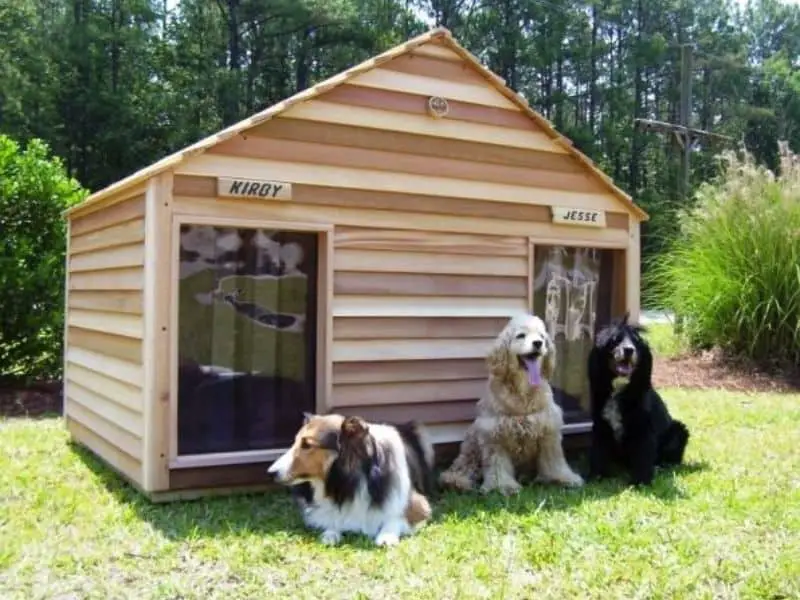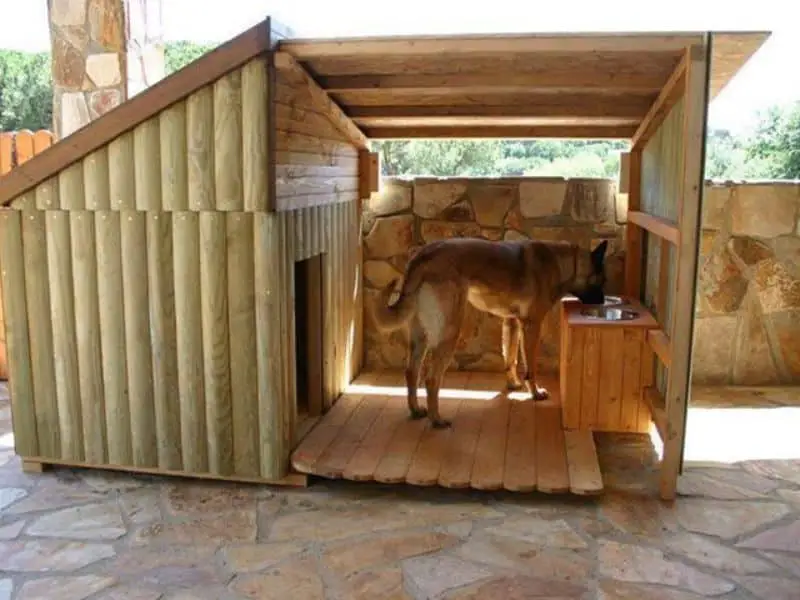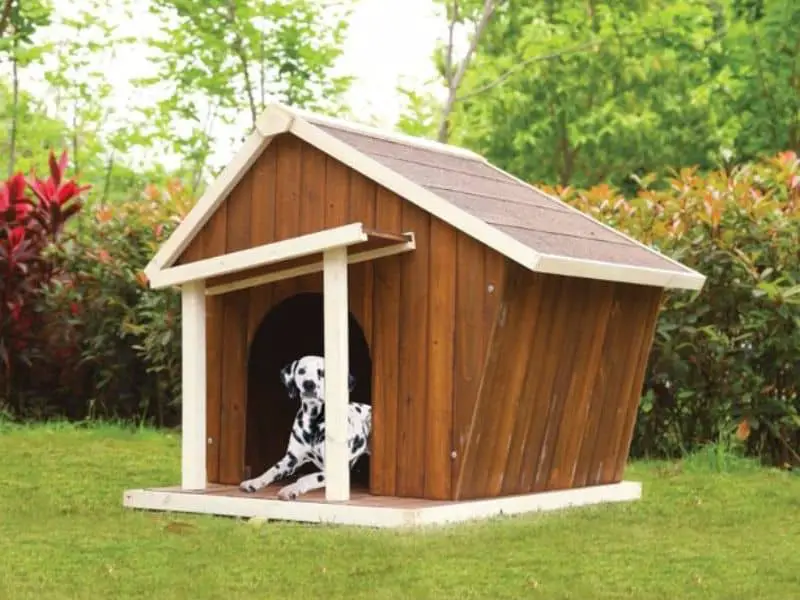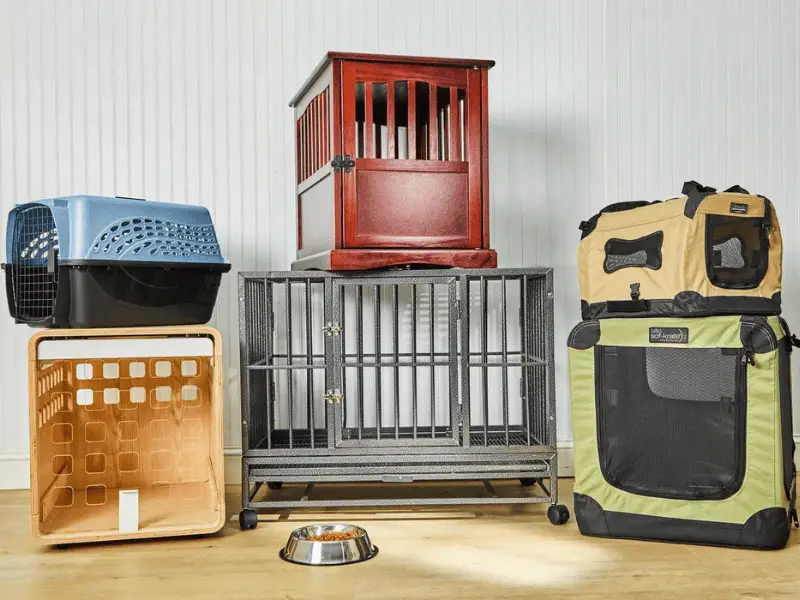Choosing the right dog house size can significantly impact the comfort and well-being of your beloved pet.

In this post, we will explore the importance of selecting the appropriate size for your dog’s house and address the conflicting information found on the internet regarding sizing.
By understanding these key factors, you can make an informed decision that ensures your furry friend has a cozy and secure space to call their own.
Importance of choosing the right dog house size
Selecting the correct size dog house is key for our pets’ well-being and comfort. Various factors must be taken into account when deciding on the size, although the internet provides conflicting info.
First off, factor in the dog’s weight, measurements, and height. The house should be spacious enough for the dog to enter, turn around, and lie down comfortably. Additionally, consider the location’s climate to choose the right size for optimum shelter.
Materials like wood, plastic, and metal should be thoughtfully weighed against their pros and cons. Temperature control and insulation are must-haves to keep the dog warm or cool, depending on the season.
Also, take into account the door shape and size, raised floors, and different styles of dog houses. Bedding materials should offer comfort, plus accessories like porch or awning-type covers can provide extra shade and protection. Temperature control measures can help prevent fleas.
Careful selection of the size for a dog house is essential. Research all needed measurements and ensure our pooches have a cozy, comfortable, and safe place of their own.
Mention conflicting information on the internet regarding sizing
Conflicting info on the web regarding sizing for a dog house is common. Differing sources offer varying advice, making it hard for pet owners to know which is right.
- Some say weight should be the main factor. Others push measurements such as length, width, and height.
- There’s debate about if the pup should be able to stand up fully or lie down.
- Climate impacts sizing too. Some say larger houses are needed in colder areas for extra insulation. Others believe pups generate enough heat.
- Material choice is up for debate too. Some recommend wood for insulation and looks. Others suggest plastic or metal for durability and easier cleaning.
- Plus, opinions vary on door size, raised floors, and house styles, making for conflict on the web.
Research and accurate measurements are key when choosing a size. Owners should think of the pup’s current needs and any future growth. Also, consider playtime and other spots the pup might nest.
A pet owner once bought a small house based only on weight. It was too small for the pup to turn around or stretch out. This shows why thorough sizing guidelines are important, rather than relying on arbitrary measures.
Factors to Consider in Dog House Sizing
Ensuring the right size for your dog’s house is paramount for their comfort and well-being. Let’s explore the factors to consider when determining the ideal dimensions for your furry friend’s abode.
From the dog’s measurements to the geographical location and material options to functional considerations, we will cover all the essentials to help you make an informed decision.
Plus, we’ll discuss the importance of suitable bedding and accessories to complete their cozy retreat. Now, let’s dive into the world of dog house sizing.
Size based on the dog’s measurements
Choosing the right size dog house is a must for your pup’s comfort and well-being. Weigh, height, and space requirements must be taken into account. It should be large enough for the pup to enter, turn around, and lie comfortably.
Geographical location affects the size of the house based on climate conditions. Materials like wood, plastic, or metal have their own advantages and disadvantages when it comes to temperature regulation.
Door shape and size, raised floors for water damage prevention, and different styles of doghouses are important for finding the right size. Accessories such as bedding or porch covers are also key to providing shade and comfort.
Research the measurements and make sure you pick the right size for your pup! Benefits come from selecting a size that fits and meets their needs, minimizing the risks of other nesting spots and any potential damage.
Show your commitment to their safety and comfort by making informed decisions about the dimensions of the doghouse.
Size based on geographical location
Geographical location is key when choosing the size of a dog house! Consider climate, humidity, rainfall, and winds when selecting the right size. Warm weather requires ventilation and shade. Cold weather needs larger houses with insulation.

Don’t forget to factor in these unique details to give your pup a cozy and safe spot. Make sure they have the right size house for their location – it could mean the difference between comfort and health issues.
Show your pup the love they deserve and give them a house that will make their tail wag with joy!
Material options for dog houses
When it comes to designing a dog house, material options include wood, plastic, and metal. Each one has its pros and cons.
Wood looks traditional and natural but requires upkeep and may be vulnerable to chewing or rotting.
Plastic is strong and easy to clean but can be brittle in extreme temperatures.
Metal is extremely durable and resistant to chewing but may retain too much heat in warmer climates.
Insulation and temperature regulation should also be taken into account. Insulation helps the dog house stay warm in colder weather and cool in hotter climates. Consider the climate in the geographical area when choosing a material.
Functional aspects should be kept in mind. Pick the right size and shape of the door for your pup’s access. Raised floors help with water damage during rain and snow. Plus, different styles of dog houses are available to accommodate personal preferences.
When selecting the right material for a dog house, consider all aspects, such as durability, maintenance requirements, insulation capabilities, and design features. With careful consideration, pet owners can offer their dogs a comfortable and safe shelter that meets their needs.
According to Wood Magazine’s article, wood is popular among pet owners due to its versatility and aesthetic appeal.
Finding the perfect fit for a dog house is like choosing a mate.
Functional considerations for dog house design
Designing a dog house requires taking into account various functional aspects. These include:
- The shape and size of the door for easy access.
- A raised floor design helps prevent water damage.
- Styles that offer flexibility, insulation options, and customization.
- Proper ventilation is key for temperature regulation.
- Windows and skylights can boost natural lighting and airflow.
- Security features to keep the dog safe.
- Selecting suitable bedding materials is essential for comfort.
- Porch or awning-type covers that supply shade and protection.
- Temperature control measures such as insulation should be implemented.
- Flea prevention strategies should be taken into account when choosing bedding and maintaining the dog house clean.
Pet owners can pick a dog house that not only looks great but also provides a comfortable home.
Bedding and accessories for dog houses
For your pup’s comfort, choosing appropriate bedding materials and accessories for their dog house is essential. Options include soft blankets, pillows, and specialized beds that provide insulation and support.
Attach porch or awning-type covers to the dog house for extra shade and protection from rain or snow. This gives your pup a safe and comfortable space.
To keep your pup healthy, consider bedding that helps regulate temperature. Use cooling pads in warmer climates and heated blankets in colder weather. Make sure to pick flea-resistant materials to protect your pup from infestations.
Take into account your pup’s breed, age, and health conditions when selecting bedding and accessories. This ensures they have an inviting space that makes them feel secure.
Machine-washable bedding is great for easy cleanliness. Look for durable and weather-resistant accessories to make sure they last.
Carefully choose bedding and accessories for your pup’s house to give them a place to rest, relax, and be healthy. Consider their individual needs to make sure you get the right materials.
Methods for Determining the Right Size
When it comes to choosing the right size for a dog house, there are various methods that can help you make an informed decision.
This section will explore different sizing methods, discuss the recommended approach, and highlight the significance of selecting the proper dog house size for your furry friend’s well-being. So, let’s dive into the details and ensure your dog has a comfortable and spacious shelter!
Different sizing methods available
Let’s look closer at the different sizing methods available in a tabulated format.
| Sizing Methods | Description |
|---|---|
| Ashville NC Humane Society’s method | This method takes into account a dog’s weight, measurements, and height requirements to determine an ideal size. |
| ABC method | Simple and adaptable guidelines to choose the right size based on the dog’s measurements. |
| Wood Magazine’s method | Considers the dog’s weight and measurements to ensure proper space. |
| Ontario Humane Society’s method | Guidelines for selecting an appropriate size by considering the dog‘s weight, length, and standing height. |
These sizing methods offer valuable insights and considerations for choosing the right size. Though they may vary slightly, their overall goal is to give guidance to create a cozy, comfortable, and secure space for dogs.
It’s important to note that deciding the right size for a dog house isn’t just about following one specific sizing method. Research and consider the climate conditions, material options, door shape and size, bedding materials, temperature control, and flea prevention measures.

Pro Tip: When using sizing methods, aim for practicality over excess space. Give enough room for the dog to enter, turn around comfortably, and lie down. This is crucial for their well-being.
Size matters for your furry friend’s house, so let’s use an adaptable sizing method to make sure they’re comfortable and safe and have room for those dance parties!
Recommended sizing method
Need help finding the perfect size for your pup’s house? There are methods to choose from.
The Ashville NC Humane Society suggests measuring your dog’s length from nose to tail base with 2-4 extra inches for comfort.
It is recommended to add length (from nose to tail), height (ground to the highest point on their shoulder/head), and 12 inches for space.
Wood Magazine suggests adding length (nose to tail) and height (ground to top of shoulder) for movement.
The Ontario Humane Society uses weight categories to determine the minimum dimensions.
Measure length and height according to the methods above for comfy, safe, practical pup homes. The size of the house affects your pup’s well-being, so choose wisely.
This eliminates the risks of alternative nesting spots or damaging household items. Lastly, consult a vet or pet expert for individualized advice based on breed, age & health.
Importance of dog house size for the dog’s well-being
The size of a dog house is extremely important for a pup’s well-being. It directly affects their comfort, safety, and happiness. A too-small dog house can restrain movement and prevent them from lying or turning comfortably.
It can also be dangerous, as there is not enough room for them to move around without bumping into something.
The size can also affect the temperature, as a snug but sufficient house can help keep them warm in colder weather and allow for air circulation in hotter months.
Furthermore, a spacious house can provide mental stimulation and an inviting space for them to explore, play, and relax. If they do not have an appropriately sized house, they may search for other areas, which can lead to damage to the house and accidents or injury for the pet.
It is essential to take into account the individual canine’s weight, height, and measurements when selecting a house.
Several sizing methods, like the Ashville NC Humane Society’s or Wood Magazine’s, are available to ensure the perfect fit. The story of Max, a Labrador Retriever rescued from a shelter, demonstrates the need for a properly sized dog house.
He became restless and agitated in a too-small house; however, he was much calmer and content when moved to one that fit him correctly.
Ultimately, size does matter when it comes to giving your pup a cozy and comfortable home.
Choosing the Right Dog House Size
When it comes to choosing the right size for a dog house, thorough research and accurate measurements are crucial.
In-depth research and precise measurements are essential when picking the size of a pooch house. Ignoring this procedure can bring about uneasiness, well-being issues, and impractical living conditions for the canine.
To guarantee the correct size, it is imperative to comprehend the dog’s estimations, including its weight, length, and width. Thinking about these estimations will help decide if the house is sufficiently huge for the canine to enter, turn around, and serenely lie down.

Geographic area likewise assumes a significant job in picking the suitable size. In more sultry climate conditions, giving satisfactory ventilation and adequate air course inside the house is significant.
For colder atmospheres, protection is fundamental, requiring additional room to oblige protecting materials or bedding.
Various materials have their advantages and disadvantages with regards to pooch houses.
Wood offers great protection yet may require customary support.
Plastic houses are lightweight and simple to clean however may not give extraordinary protection.
Metal houses are strong yet may need extra protection against outrageous temperatures.
Practical contemplations for the plan of a pooch house incorporate the suitable shape and size of the entryway for simple access by the canine.
Raised floors can forestall water harm during stormy seasons or in flood-inclined regions. Various styles of houses offer fluctuating degrees of solace, for example, those with raised galleries or awning-sort covers for shade assurance.
Bedding materials can upgrade the solace inside the pooch house. Adding gallery or awning-sort covers can offer extra shade from coordinate daylight or assurance from downpours. Temperature control and flea counteractive action measures should likewise be thought of.
A comprehensive examination and exact estimations are critical to guarantee the prosperity and joy of the pooch.
Neglecting to pick the correct size for a pooch house may bring about the canine looking for optional nesting spots or probably causing harm to its environmental factors.
By prioritizing research and estimation, proprietors can make a comfortable, comfortable, and safe space that meets their canine’s particular needs. Don’t let your pooch feel like they’re in a confined studio condo; give them the correct size pooch house and watch their tails wag with delight!
Summary of key considerations and guidelines for selecting the right dog house size
Throughout time, pup owners have encountered the challenge of picking the right size for their pet’s home. To help guarantee that doggos have a cozy, comfortable, and secure space of their own, diverse methods and rules have surfaced.
To dodge potential problems that could affect the dog’s health and bliss, thorough research and accurate measurements are essential.
Considering these, owners can give their furry friends a suitable house that matches their precise needs.
Factors to Consider in Dog House Sizing:
- Size based on the dog’s measurements
- Size based on geographical location
- Weight, measurements, and height requirements
- Enough space to enter, turn, and lie down
- Impact of climate (warmer and colder weather)
Material options for dog houses:
- Wood, plastic, and metal
- Insulation and temp control
Functional considerations for dog house design:
- Door shape and size
- Raised floors for water prevention
- Varied styles of dog houses
Bedding and accessories for dog houses:
- Suitable bedding materials
- Porch or awning-type covers for extra shade and protection
Recommended sizing method:
- Simple and adaptable guidelines
- Ensuring comfort, safety, and practicality
Ensuring a cozy, comfortable, and safe space for the dog.
Choosing the right size for a dog house is key. Account for the pup’s weight, measurements, and height. Geographical location also plays a role in size. Warmer areas require larger houses with ventilation and shade. Colder climates need houses that are insulated to keep them warm.
Functional design must be considered too. Factors such as door shape and size, raised floors for water damage prevention, and different styles of dog houses should all be assessed. These features all contribute to the pup’s comfort and safety.
To determine the right size, use sizing methods like the Ashville NC Humane Society’s or ABC methods. This ensures that the dog has ample space while prioritizing its comfort and safety.
Creating an environment suited to the pup’s needs is essential. Consider the dog’s size, climate, and functional design features to make a cozy, comfortable, and safe space.
Provide a house that’s big enough to move around, insulation for colder climates, and ventilation for warmer areas. By factoring in these considerations and following sizing methods, you can provide the pup with a special place all its own.
Size Matters: How to Choose the Right Dog House Size
- It is important to consider the weight and measurements of the dog when choosing a dog house.
- The ideal dog house size is just big enough for the dog to enter, turn around, and lie down.
- The dog house size can affect the retention of the dog’s body heat.
- Geographical location should be considered when deciding on the dog house size.
- Wood is the best insulator for dog houses, and it is recommended to have a total wood roof for heat retention.



Leave a Reply